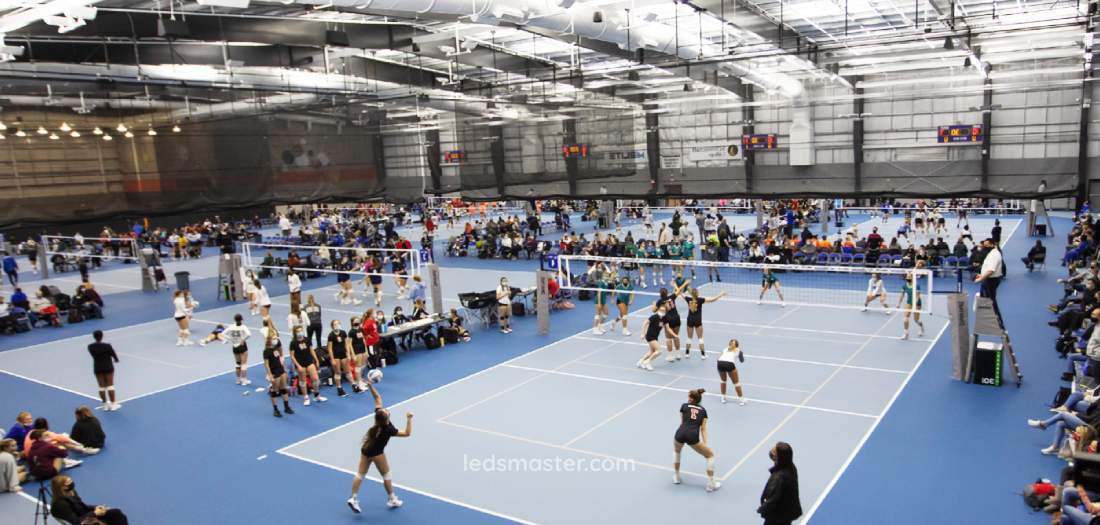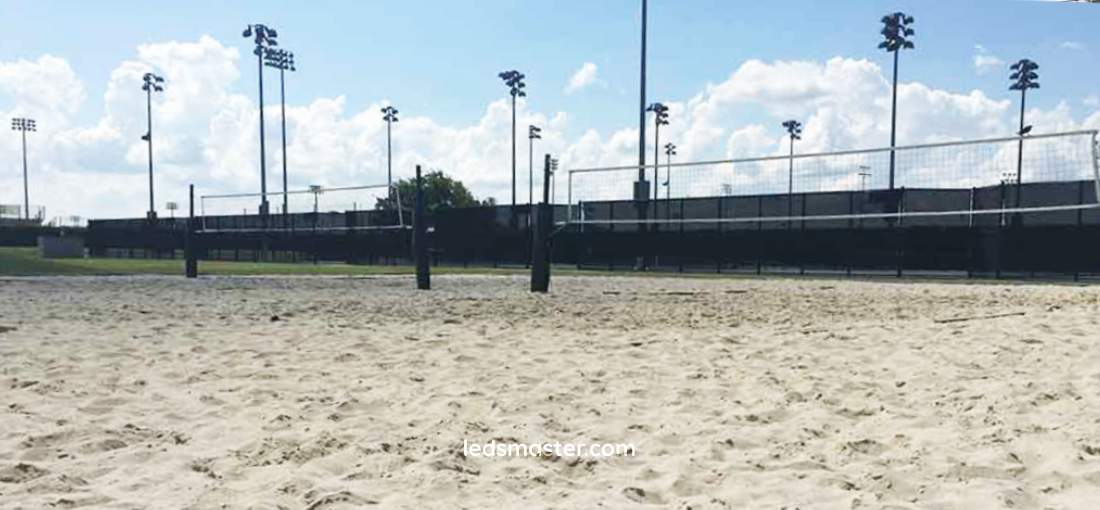Transform your volleyball court into a vibrant arena where every game stands out with exceptional clarity and precision. Our state-of-the-art lighting solutions are crafted to enhance every moment, from casual matches to high-profile tournaments. By combining innovation with excellence, we ensure that each play is captured with remarkable detail and consistency. Elevate your game experience with lighting that exceeds expectations, creating an environment where players and spectators alike can fully appreciate the excitement and intensity of the game.
Get your complimentary lighting design today
We provide top-tier volleyball court lighting solutions that meet the rigorous standards required for both recreational play and prestigious events, including NCAA tournaments and Olympic Games. Proper lighting is a crucial element for both indoor and outdoor volleyball courts. To ensure optimal visibility and functionality during nighttime play, high-quality LED volleyball lights are essential. These lights must deliver not only sufficient brightness but also a uniform distribution of light across the entire court. Let’s explore the key considerations for effectively illuminating a volleyball court.
Table of Contents
ToggleWhen designing lighting for a volleyball court, it is essential to consider both the dimensions of the field and the required brightness levels. Standard volleyball courts measure approximately 30 feet by 60 feet, with the net height for men’s games set at 7 feet 11 5/8 inches. The brightness, or lux level, needed for proper illumination varies depending on the level of play.
For recreational or lower-level competitions, a brightness range of 75 to 200 lux generally suffices. This range ensures that players have adequate visibility while accommodating a less intense environment.
In contrast, professional and high-level tournaments require a minimum brightness of 500 lux. This higher lux level is necessary to provide exceptional clarity and ensure that every detail of the game is visible, which is crucial for both players and spectators.

Lighting uniformity is another critical factor that affects the quality of illumination on a volleyball court. Brightness alone is not enough; the even distribution of light across the playing surface is essential to avoid shadows and ensure consistent visibility.
For professional competitions, a lighting uniformity ratio of 0.7 is considered ideal. This ratio ensures that the light distribution is sufficiently even, providing a high standard of visibility throughout the game.
In recreational settings, a slightly lower ratio of 0.5 may be adequate. Our lighting solutions are designed to achieve a uniformity ratio of 0.75, which meets the requirements of nearly all levels of play. To further improve lighting uniformity, we can employ an indirect lighting approach. This technique involves directing ceiling flood lights upward, allowing the light to reflect off the ceiling and distribute evenly across the court.
This method helps to achieve a more consistent lighting effect. Our team of engineers is available to offer personalized consultations and design recommendations to ensure optimal lighting performance.
To ensure the effectiveness of our lighting solutions, we utilize advanced software tools such as DIALux for photometric lighting design. This technology allows us to create detailed and accurate lighting plans for volleyball courts. The photometric design process involves simulating the lighting environment and its effects before the actual installation takes place. This simulation provides us with valuable insights into how the lighting will perform in real-world conditions.
We generate proposals that include false color renderings, isolines, and other graphical representations to predict and assess the brightness and uniformity across the court. These detailed plans help us fine-tune the lighting setup to meet the specific needs of the venue and the level of competition.
Another important consideration for volleyball court lighting is the performance of the LEDs, particularly in high-speed situations. Our high-end optics are engineered to be flicker-free, which is crucial for capturing fast-moving action in volleyball games.
Flicker-free lighting supports filming at frequencies up to 6000 Hz, ensuring that rapid movements and intense gameplay are captured with clarity and precision. This feature is essential for high-speed photography and video recordings, allowing for clear and detailed footage of the game.
For outdoor volleyball courts, weather resistance is a key factor in the durability of the lighting fixtures. Our sports floodlights are designed to be waterproof, capable of withstanding adverse weather conditions such as heavy rain and storms. This durability is especially important for fixtures mounted on high mast poles near the court.
What is more, our premium LED lights are engineered to endure temperatures up to 100°C, thanks to our advanced 4th Gen Solid-stage Packaging™ Technology. This feature ensures that the lights remain reliable and effective, even in challenging environmental conditions.
In indoor settings, managing heat generation is crucial to maintain the performance and longevity of lighting fixtures. While heat is a natural byproduct of lighting, persistent heat can lead to damage of the components, reducing brightness and overall lifespan. Our flood lights are designed with a dense fin structure that enhances heat dissipation, effectively lowering the junction temperature of the lights. This design feature ensures that the lights remain cool and operational, even when installed on indoor ceilings. For additional support and information regarding our lighting solutions, please do not hesitate to contact us.

Once you have addressed the critical factors of brightness, uniformity, and flicker-free performance, the next step in optimizing volleyball court lighting involves focusing on the arrangement and specifications of the poles that support the lighting fixtures. The arrangement of these poles can significantly impact the overall effectiveness and safety of the lighting system.
In designing the lighting for a volleyball court, the configuration of the poles is a key consideration. Common arrangements include setups with 4 poles, 8 poles, or even more, depending on the specific requirements of the court. The height of these poles also varies, and each arrangement comes with its own set of advantages and challenges.
For instance, if fewer, taller poles are used, each pole will need to support more powerful LED lights. While higher power LED lights can provide greater illumination, they also add more weight to each pole. This increased weight necessitates careful consideration of the pole’s structural integrity. The poles must be capable of supporting the combined weight of the lighting fixtures without compromising safety.
The weight of the lighting fixtures is a critical factor in pole design. Higher power LED lamps are often heavier, and if too many or too heavy fixtures are mounted on a single pole, it can exceed the weight limits established for safe operation. This overloading poses a significant safety risk and can lead to structural failures or accidents.
To mitigate these risks, our products are constructed from high-quality aluminum alloy. This material is known for its strength, durability, and lightweight properties. It provides an optimal balance between sturdiness and reduced weight, ensuring that the poles can support the necessary number of luminaires without requiring excessive reinforcement.
In scenarios where heavy or numerous lighting fixtures are installed on poles, additional reinforcement may be needed to support the weight. This reinforcement often involves additional structural supports or modifications to the existing pole setup. However, this can lead to increased costs, sometimes reaching levels comparable to or even exceeding the cost of the lighting fixtures themselves.
By selecting our aluminum alloy fixtures, you can minimize the need for costly reinforcements. The lightweight nature of these fixtures helps keep the total weight within safe limits, reducing the need for additional structural support and thereby lowering overall costs.
Designing optimal lighting for volleyball courts involves several essential considerations. Proper illumination is critical, with 75 to 200 lux needed for recreational play and a minimum of 500 lux required for professional tournaments. Achieving uniform light distribution is also vital to avoid shadows and ensure clear visibility, with a target uniformity ratio of 0.75 for most settings.
Our flicker-free LED technology enhances clarity, particularly for high-speed action, while our fixtures are built to withstand both outdoor weather conditions and indoor heat. The use of high-quality, lightweight aluminum poles helps manage weight and costs, ensuring structural safety and reducing the need for additional reinforcement. For customized lighting solutions and expert guidance, our team is available to assist.